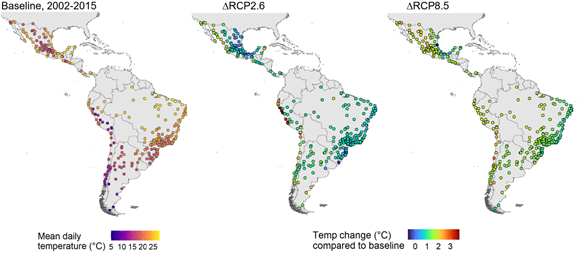Heat-Related Deaths in Latin America Projected to Double by 2050
PHILADELPHIA, PA,
October 6, 2025
Reading time: 4 min
Heat-related deaths in Latin America are projected to double by 2050, according to a new SALURBAL study published in Environment International. The projections analyzed the impacts of temperature and aging populations on future mortality in 326 cities across nine Latin American countries: Argentina, Brazil, Chile, Costa Rica, El Salvador, Guatemala, Mexico, Panama, and Peru.
The research compared two possible climate futures: one with strong policies to reduce greenhouse gases, and a second with high emissions and little action to mitigate them. The study found that even with strong efforts to transition to a low greenhouse gas scenario, heat-related deaths in the region are expected to double by mid-century compared to the baseline from 2002–2015. This increase is primarily due to an aging population, which is more vulnerable to heat.
The study, “Future temperature-related mortality in Latin American cities under climate change and population scenarios,” was co-led by Maryia Bakhtsiyarava, PhD, and Josiah L. Kephart, PhD. Both are assistant professors at the Drexel University Urban Health Collaborative and are part of the Salud Urbana en América Latina (SALURBAL) initiative. The research also included co-authors from the University of North Carolina at Chapel Hill, the University of California at Berkeley, the Federal University of Minas Gerais, and the University of São Paulo—the latter two in Brazil.
- Heat-related deaths in Latin America are likely to double by 2050, even if global temperatures rise at a moderate pace. The study also shows that under a more extreme global warming scenario, the percentage of all deaths related to extreme heat could rise from 0.87% to 2.06%.
- Major demographic changes, driven by an aging population, will magnify the impacts of heat. While experts also anticipate that public health efforts will continue reducing deaths from both heat and cold, these improvements may not be enough to counter the growing risks from a warming climate and major demographic shifts: a larger, older population will be more vulnerable to extreme temperatures.

Fig. 1. City-level daily mean temperature at baseline period (left) and projected changes in daily mean temperature from baseline period to 2045–2054 under a moderate warming scenario (middle) and a high increase in temperature (right).
According to the paper, nearly every city in the study will experience warmer average temperatures under future climate scenarios. Even with a moderate warming scenario, heat-related deaths in the region are on track to double by 2050. This alarming increase will be significantly driven by a demographic shift that could raise the heat-related mortality rate by 176% on its own.
“This analysis emphasizes that urban heat is a rapidly growing threat to health in Latin America, a threat that comes from two main factors: climate change from human activities and a population that is rapidly aging, leaving more older adults especially vulnerable to heat,” says Josiah L. Kephart, PhD, co-lead author of the study and Assistant Professor at Drexel University’s Urban Health Collaborative.
Rising temperatures will directly impact health. While some cities, like Buenos Aires, may see a reduction in cold-related deaths, this will be far outweighed by a sharp increase in deaths caused by extreme heat. For example, Rio de Janeiro is projected to experience extreme heat beyond anything that has been observed, substantially raising deaths due to heat. Across 152 Brazilian cities, heat-related deaths are estimated to account for 1.82% of all deaths under the moderate warming scenario and 2.43% under the high-emission scenario by mid-century.

“Rising temperatures combined with rapid population aging will significantly amplify health risks, leading to more preventable deaths. Anticipating these trends would enable governments to incorporate targeted adaptation strategies into urban planning and health systems, with particular attention to the needs of older adults,” says Maryia Bakhtsiyarava, PhD, co-lead author of the study and Assistant Research Professor in Drexel's Urban Health Collaborative.
For policymakers and healthcare professionals, this would mean investing in heat action plans, cooling infrastructure, and health surveillance, while tailoring and prioritizing responses to the diverse climate and socioeconomic conditions of cities across the region.
“For cities, this study reveals the magnitude of the challenge ahead. It encourages officials and decision-makers to focus on the populations most highly susceptible to the effects of heat, like older adults and individuals with other diseases," says Daniel Rodriguez, PhD, senior author of the study and director of the Institute of Transportation Studies at the University of California, Berkeley.
While general health improvements may lower overall death rates, these gains will be offset by more frequent exposure to dangerous heat and a growing older adult population. This underscores the urgent need for targeted strategies that protect public health, particularly that of aging populations, through urban planning and climate change mitigation and adaptation policies.
—---
This study was financially supported by the Wellcome Trust (216029/Z/19/Z, 205177/Z/16/Z, 227810/Z/23/Z).
Contact: Carolina Rendón, Communications Specialist - cr3283@drexel.edu